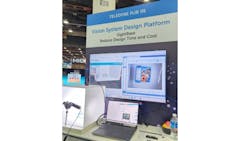When I attended my first Automate show two years ago, I had been working for Vision Systems Design for less than a month. Not only had I plunged headfirst into the world of automation in general and machine vision in particular, but part of that plunge was a serious moment of sensory overload; a newbie simply dazzled by all the innovation surrounding him at every turn.
Two years later, I am pleased at how much I have learned, but far more amazed, and a little daunted, at how much I don’t know and probably never will.
This year, I only had one day at Automate, so meeting, greeting, and catching up with the latest developments was—well, I don’t know that I would go so far as to liken it to speed dating—something of a whirlwind. On the other hand, this time I had a better idea of where I was going and who and what I was going to see, which made it easier to avoid the lure of the rabbit hole.
Our day actually started with our eleventh annual Vision Systems Design Innovators Awards presentation program, which recognizes and celebrates innovations and products across the machine vision industry. Needless to say, our honorees are some of the best and brightest, and they do a great job not only of improving existing miracles but pushing the boundaries of what is both practical and possible.
But they aren’t the only ones…
Last time I was here, the show seemed to be all about robots. And while there were still plenty of them and robots are going to be the most obvious attention getter, I felt like robots weren’t quite as overwhelming and ubiquitous a presence as they seemed to be in 2023.
There are many different companies and areas of our industry that may not be as immediately eye-catching, or even as visible, as, say, a quadraped robot doing backflips, or a humanoid robot loading and unloading packages on a conveyor belt. But these folks are producing amazing, innovative things. For example, Zivid (Oslo, Norway), a company that specializes in 3D vision cameras, not only works in areas such as bin picking with major e-commerce retailers (literally the eyes of the robots) but is also moving into sectors such as the aerospace industry. In fact, Gray Matter Robotics (Los Angeles, CA, USA) is using Zivid 3D cameras with a robotic system that is designed to uniformly sand away extremely tiny layers of paint from aircraft parts.
Companies such as Metaphase Technologies (Bristol, PA, USA) and Smart Vision Lights (Norton Shores, MI, USA) are doing some interesting work in lighting, not only with lighting technologies but with versatility and ease of configuration. For example, Smart Vision Lights’ LSR 300 configurable bar light is designed so that users can take the end cap off the bar and slide in an entire set of different lenses mounted on a small portable strip. The idea is to allow the user to quickly change and adjust the lighting on the spot without having to remove the light bar and/or physically dissassemble and reassemble it.
Need help putting together your next vision application? Teledyne FLIR (Wilsonville, OR, USA) has a new feature on its website, known as SightBase, which allows users to virtually configure and test Teledyne components such as cameras and lenses to see how they will work with different machine vision applications. Teledyne also has an online questionnaire that can help potential customers, especially those with more limited machine vision experience, narrow down the goals and functionalities of a proposed machine vision application to help the customer choose the most appropriate components for the application.
All things considered, the overall outlook, at least to me, seems positive when it comes to the future of the industry. Not only were companies at the show pretty much universally optimistic, but at least one market research firm, Interact Analysis Northampton, UK), is projecting steady and solid growth for the machine vision industry over the next few years.
Related: When Will Growth Return to the Machine Vision Market?
Correspondingly, one point that struck me throughout the day—granted, an obviously imperfect personal perception —was that there seemed to be more new companies at this year’s show, certainly more than I recall from Automate 2023. These ran the gamut from camera and imaging applications—one example was Hellbender (Pittsburgh, PA, USA) an AI-camera and imaging solutions start up—to software, connective components, even entire vision systems.
These are all companies started by smart, ambitious, dedicated, innovative, interesting go-getters. So, to me, given the uncertainty of the times, it’s heartening to see that when it comes to chasing dreams and bringing them to fruition, there a lot of folks out there who are ready, willing, and capable—and they’re in it to win it.
About the Author
Jim Tatum
Senior Editor
VSD Senior Editor Jim Tatum has more than 25 years experience in print and digital journalism, covering business/industry/economic development issues, regional and local government/regulatory issues, and more. In 2019, he transitioned from newspapers to business media full time, joining VSD in 2023.

